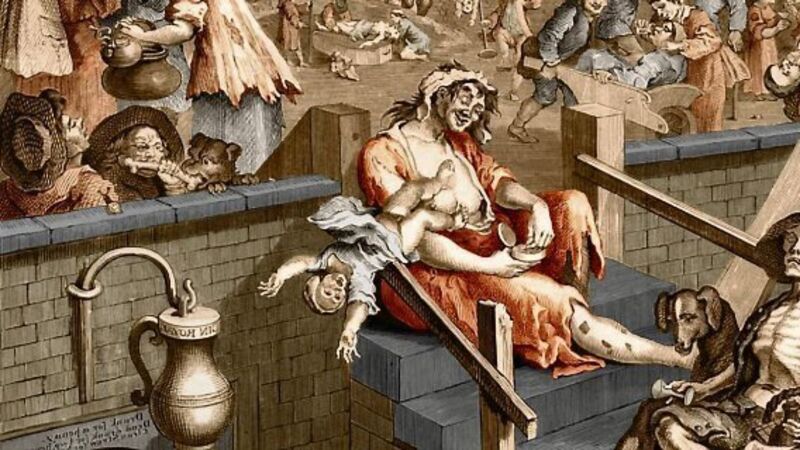Gin Lane’s alcoholic miseries are still to be seen on streets of Ireland

Hogarth cheaply sold prints of the cartoon, because he wanted the ‘movers and shakers’ of his time to understand what was happening, and his pal, writer Henry Fielding, supported him.
“In Gin Lane,” Hogarth said, “every circumstance of [gin’s] horrid effects is brought to view...Idleness, poverty, misery, and distress — which drives even to madness and death — are the only objects that are to be seen, and not a house in tolerable condition, but the pawnbroker’s and gin-shop.”
The gin shop, in common with its like on every city street corner, promised patrons:
Drunk for one pence
Dead drunk for twopence
Clean straw for nothing.
The rich might have tut-tutted, but the rich didn’t walk through the streets as Hogarth and Fielding did, and so were able to ignore what the artist captured and what was to become a public health disaster. A professor of history at the University of Toronto, Jessica Warner, points to detail within the cartoon to underline the ruthlessness of Hogarth’s eye.
“At the centre of the scene,” she writes, “is a besotted mother whose infant, a boy, is about to plummet to his death. The boy’s eyes are strongly suggestive of fetal alcohol syndrome, as are those of the infant on the right margin of the print. In the background, another infant sits and bawls as its naked mother is placed in a coffin.”
Hogarth was the nearest the 18th century had to a concealed camera, and a right good job he did of incorporating, in one scene, all of the damage done by the 30-year gin craze he had witnessed. High on the right of the drawing, and easy to overlook, is a window through which can be distinguished the emaciated shape of a man hanged by his own hand. The artwork shows an abandonment of privacy and self-respect so florid, the temptation is to believe it to be vulgar exaggeration. It wasn’t.
One parliamentarian, Lord Lonsdale, made that clear.
“Whoever shall pass among the streets will find wretches stretched upon the pavement, insensible and motionless, and only removed by the charity of passengers from the danger of being crushed by carriages, or trampled by horses, or strangled with filth in the common sewers...and others, less helpless perhaps, but more dangerous, who have drank too much to fear punishment, but not enough to hinder them from provoking it, who think themselves, in the elevation of drunkenness, intitled to treat all those with contempt whom their dress distinguishes from them, and to resent every injury which, in the heat of their imagination, they suppose themselves to suffer, with the utmost range of resentment, violence of rudeness, and scurrility of tongue...”
Gin became the drug of choice for London’s poor around 1720. For a population beaten down by deprivation, ‘geneva’ had major advantages over traditional ale and beer. It was cheaper, and faster in its capacity to remove hunger, cold and misery by plunging the drinker into unconsciousness. It gave rise to street gangs, and turf wars between its suppliers. It led to crime and murder, to filth, and to disease and death on an unprecedented scale. It lasted those 30 years and was ended by a combination of legislative action and a few other distractions, like war and conscription.
Now, you might not think that Health Minister Leo Varadkar has much in common with 18th century members of the English parliament, but you would be wrong. In addition, you mightn’t think that the gin craze in London has much in common with life in Irish cities right now, but you would be wrong there, too.
Varadkar has recognised that Ireland has a serious alcohol problem. The statistics have been sufficiently rehearsed since he announced his intention to do away with the below-cost selling of alcohol.
But the ensuing discussion has dealt with the statistics as statistics, shorn of human consequence. We have no Hogarth, although the street-scape he sketched, back then, is reasonably contemporary. Vomiting in the street? Standard. Urinating? Ditto. “Wretches stretched out on the pavement, insensible and motionless”? Definitely. Comatose drunks being transported in wheeled vehicles organised by friends? That’s a constant.
Aggressive thugs who “resent every injury which, in the heat of their imagination, they suppose themselves to suffer, with the utmost range of resentment, violence of rudeness, and scurrility of tongue...”? Anybody out late on a Friday night, in any Irish city, has to avoid the modern version of Lord Lonsdale’s intoxicated lads.
Less evident is the link between our excessive alcohol consumption and the suicides about which we now constantly talk.
Not evident at all — yet — are the numbers of babies afflicted with fetal alcohol syndrome, the outward and visible signs of which Hogarth noted without knowing the life-long limitations posed by the syndrome.
What is strikingly evident is how committed to denial are folk who flatter themselves that they don’t drink excessively.
Damaging, pointless denial, like the suggestion that motherhood is so stressful that a young woman should need a couple of glasses of wine once she has the children stowed in their beds at night.
Now, for starters, parenthood is arguably less stressful than at any earlier time in history, given the quality of medicine, paediatricians, vaccinations that remove the possibility of dying from diseases like dyphtheria, playgroups, creches and childminders.
But even if motherhood were more stressful, to recommend a nightly relaxer in the form of several units of alcohol is willfully irresponsible.
The stressed mother could take exercise, read a book, talk to a friend, knit a jumper, say a prayer, adopt a yoga pose or undertake any number of other, non-habit forming activities which would not slow her response to an emergency involving one of her children. She would not then develop in her mind and physiology an unjustified association between coping and alcohol.
Denial also surfaced in frankly silly comments like “this is too little, too late” or “this is the nanny state in action.” Underlying almost all of the discourse was a passing, but half-hearted, acknowledgement that Ireland may have a bit of a drink problem, all right, but that it’s cultural.
Of course it’s cultural. But you know something? Culture isn’t like the weather. It doesn’t just happen. Like a pointillist painting, it is made up of a million individual inputs.
Each one of us decides the national culture. But most of us find it easier to blame our drink culture on someone else, someplace else.
Every detail of the painting tells the story of what one alcoholic drink — gin — was doing to the poor















